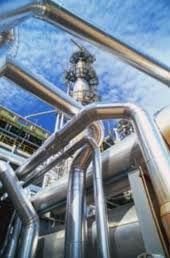
The International Energy Agency (IEA) recently issued a special report in its World Energy Outlook 2011 series titled Are we entering a golden age of gas? The report is specifically
related to current and future use of natural gas.
There is no doubt that natural gas has attracted more attention in the last two decades than ever before. It has become the fuel of choice for its environmental qualities compared to other fossil fuels, its ease of use and often competitive prices. The development in gas turbines and the perfection of the combined cycle in electricity generation, made natural gas the preferred source for efficiency improvements as well. This combined cycle is achieving efficiency close to 60 per cent compared to the highest efficiency seen for coal plants at 47 per cent.
Of course for those who are much concerned about energy security, the diversification into natural gas became an element in their policy, especially that natural gas resources, unlike oil's, are much more spread around the world and their availability is enhanced by the development in unconventional gas resources and production.
Therefore, IEA develops its scenario for a "golden age of gas" based on the assumptions that gas prices will remain competitive though slowly rising, that lower nuclear electricity growth rates will emerge especially after the Fukushima disaster, that China will succeed in its ambitious drive to use natural gas and that the inroads of natural gas into the transport sector will continue.
Share to rise
In this scenario, total primary energy is expected to increase from 12,271 million tons of oil equivalent (mtoe) in 2008 to 16,765 mtoe in 2035 and natural gas demand from 2,569 mtoe to 4,244 mtoe in the same period. Gas share in the energy mix is therefore expected to increase from 21 per cent in 2008 to 25 per cent in 2035. The gain in share will be at the expense of oil's and coal's shares.
But this scenario does not really account for recent policy changes in the use of nuclear energy in the aftermath of the Fukushima disaster. The 330 GW of new nuclear capacity that is expected to be added by 2035 in the IEA forecast is unlikely to materialise.
Only recently, Fatih Birol, the chief economist of IEA, said that only 180 GW may be added due to many countries curtailing their plans or abandoning them altogether. If so the demand for gas may be some 200 mtoe more by 2035.
At the same time, the penetration of natural gas into the transportation sector is slow even though the potential and advantages are high. There are only 12 million vehicles worldwide consuming 20 billion cubic metres (bcm) or less than one per cent of total road fuels in energy terms.
The IEA suggests that the number of vehicles can increase to 70 million given the price differential to gasoline and diesel, the environmental advantages, improved efficiency and lower running cost in terms of maintenance and longer life for vehicles. But for this to happen, government support is necessary at least in the initial stages.
Evolution of regional demand in this scenario is interesting. While OECD demand is likely to grow by 0.9 per cent a year, the demand in non-OECD region is likely to grow by 2.6 per cent a year. The demand in China and India is likely to be the fastest growing around the world or at rates of 7.7 per cent and 6.5 per cent respectively.
The Middle East may see a growth rate of 2.4 per cent but the IEA suggest that 60 per cent of the growth is expected to be feedstock for gas to liquids projects. This may not happen as there is great demand for gas in electricity generation and the desire of many countries to suppress the use of liquid fuels in favour of natural gas.
The growth in demand is propelled by economic growth leading to higher household income and more industrial development in addition to the growth in electricity generation which is likely to the biggest factor. Environmental factors are also important for countries with policies to reduce greenhouse gas emissions and local pollution.
Once the supply is available and infrastructure is in place there is definitely a desire by consumers to use more natural gas. More on this next week.
Source: Gulf News
We use cookies to improve your experience. By continuing to use our site, you accept our Cookies, Privacy Policy,Terms and Conditions. Close X